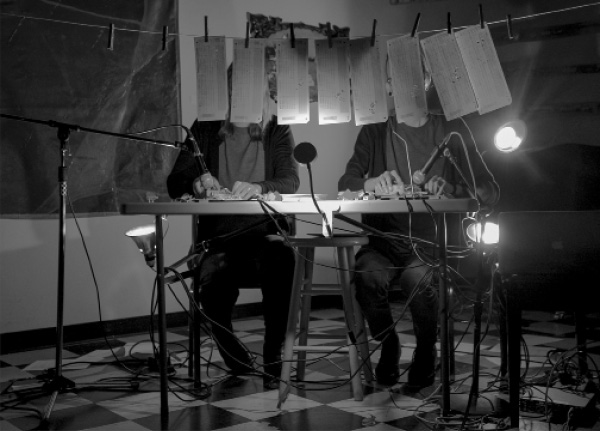
WHISPERING DISTANCE
first performed on November 4, 2017
The Jazz Galery, Milwaukee, WI
performed once in 2017
SARAH HENNIES / JASON ZEH
Kansas City, MO / Ithaca, NY
981157190z981157190e981157190h981157190.981157190j981157190a981157190s981157190o981157190n981157190@981157190g981157190m981157190a981157190i981157190l981157190.981157190c981157190o981157190m
jasonzeh.com / sarah-hennies.com
WHISPERING DISTANCE
SARAH HENNIES / JASON ZEH
This performance, presented as part of FTAM Productions’ Experimental Education Series, explores issues surrounding confession, intimacy, and attempts to quantify identity. The work gives the impression of a deeply personal, embarrassing, or vulnerable mode of secret-sharing while simultaneously erecting barriers preventing listeners from fully accessing the truth of the secrets being confessed.
The work utilized several sound-producing actions. In phase one of the piece, Hennies and I filled in BubbleScan test forms using screws to tear holes in the sheets. The multiple choice and true/false questions were derived from confessions that we wrote. These test forms were placed on top of wooden clipboards that were wired to amplify the sounds of the action. At the end of each set of five questions, we spoke a single word through a metal drinking straw before clipping the test sheet to a clothesline hanging in front of our faces. During this phase of the piece, test sheets accumulated on this string, eventually obscuring the audience’s view of us aside from small points of light that shone through the holes in the paper. Here, a standardized test serves as a tool for quantifying and dissecting our secrets while visually blocking out our bodies. Speaking through the straws, an action inspired by vocal exercises designed to strengthen the voice, both facilitates and frustrates communication.
During another phase of the performance, we turned to face one another while using a touch-sensitive device to affect the playback of two retellings of personal secrets. Each of our secrets were told in our respective voices, in the other’s voice, and in several transformed versions of both voices. The result was a confession of secrets that refused the desires of the audience to know definitively which secret belonged to which one of us. In the act of confession, both of our identities were momentarily merged into one through the communication technologies in play. During this secret-telling phase, both of us were responsible for managing an ever-growing and ever more unwieldy collection of sound-making toys like wind-up teeth and spinning tops that danced on top of the amplified clipboards.
The final phase of the piece involved taking down the test forms from the clothesline one-by-one and sanding the sheets down to scraps with a wooden sanding block. This action took place on top of the amplified clip boards and ended with a quietly spinning top and darkness.